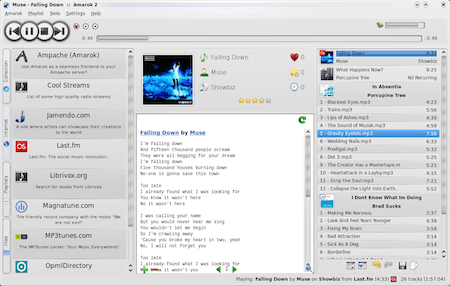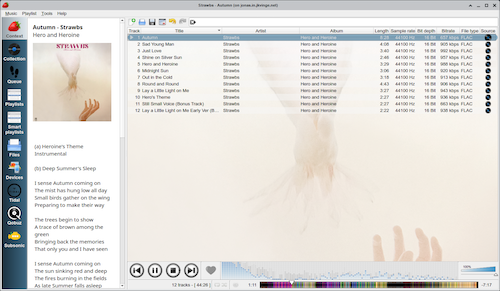Amarok 2.0 - The Rise and Fall

As a previously devoted user of the KDE Plasma platform during its earlier iterations, I’ve always enjoyed the applications that the development team has provided as part of the default package of packages available with KDE Plasma.
From my earliest experience with KDE with its 3.0 release I had been on a quest to find the perfect audio player. At the time the most popular Linux audio player was the utilitarian XMMS app which was heavily inspired by the look and feel of WinAmp on Windows. Eventually I came across Amarok which introduced me to a more feature-rich audio experience with an interface that shared similarities with an application like iTunes as opposed to WinAmp.
Amarok’s Beginnings
My journey into the world of KDE Plasma and Amarok was marked by Amarok’s ascendancy within KDE. Amarok transformed audio playback on KDE and provided users with a feature rich audio player with a polished interface. Amarok’s design aimed to improve usability and provide a solid user experience for users who wanted to manage and play their music collection. Amarok eventually became the default audio player for KDE Plasma.
Amarok 2.0’s Evolution and Community Response

Despite the success that Amarok had reached, the development team made a decision to revamp the interface with their next major release - Amarok 2.0 - to match the changes that were introduced with the launch of KDE Plasma 4. Although I was enthusiastic about the changes that were made, the arrival of Amarok 2.0 was not met with unanimous support from the user community.
It is important to consider the user interface of Amarok 1.4 - although the application brought a more robust feature set the user interface was very simple with the the interface split in two halves, with the narrow left half consisting of the user’s music collection and the wider right half consisting of the current playlist with media playback controls at the bottom.
As part of the revamp Amarok 2.0 retained the same colour scheme as its predecessor but introduced a 3-column layout to replace the 2-column layout. The 3 columns consisted of the music collection on the left, the cover and additional material (such as the Wikipedia page) of the music being played, and the final column consisting of the current playlist. At the very top of the application in the title bar would be the title and album of the music with the area below it containing the playback controls on the left, a bar to indicate how much of the music has been played, and finally a volume control on the right.
For the most part Amarok 2.0 and its future releases retained a similar interface with changes occurring along the way such as the introduction of a default dark theme and replacing the media playback buttons with a single play/pause button.
It has been some time since Amarok 2.0 was released, however I recall that there was a general disappointment with the user interface changes made moreso than any backend changes that were made.
The dissatisfaction with Amarok 2.0 eventually would lead to the creation of projects like Strawberry and Clementine, which sought to recreate Amarok 1.4’s interface while incorporating backend enhancements. It was a testament to the power of open-source collaboration that these alternatives emerged as worthy successors.
The Aftermath: Strawberry and Elisa

The aftermath of Amarok 2.0's interface overhaul brought interesting changes to the audio player landscape on Linux. The first project that was released was Clementine which retained the codebase of Amarok 1.4 to develop its own audio player that would retain the look and feel of Amarok 1.4.
Other projects sprung up as a result of Amarok 2.0, including a version which was developed for GNOME, however none of these variations of Amarok ever became the default audio player for KDE or GNOME. As an unfortunate consequence of the nature of open source projects, active development of Clementine stopped as of 2016, although recently some new volunteers have started to work on Clementine and they released a preview release of their work last year.
After development of Clementine stopped another audio player soon arose to take its place in 2018 (2 years after active developed stopped on Clementine) - the Strawberry Music Player. Unlike Clementine, which was based on the code for Amarok 1.4, Strawberry was built using the code and modern enhancements that Clementine had developed on top of the original Amarok 1.4 code. Thankfully Strawberry is actively being developed with its most recent release being version 1.0.18 which was released last month.
During the same period during which Strawberry was released, another audio player was being developed by the KDE community. This new app, Elisa, was intended to be a simple audio player that for KDE Plasma. Ironically, Elisa’s appearance does appear to be inspired by Amarok 2.0, which is particularly interesting since the user interface of Amarok 2.0 was what many users found polarizing.
While Strawberry and Elisa build upon the foundations of Amarok, each player follows their own distinct path. Strawberry presents itself as a nostalgic nod to Amarok’s past, a combination of familiarity and innovation. In contrast, Elisa takes the core ideas of Amarok 2.0’s interface and aims for a more seamless and accessible execution. However, Elisa’s simplicity comes at the cost as some basic features are not present, such as the ability to set the default behaviour when double clicking on an item from the music collection.
The Legacy of Amarok 2.0 and Beyond

Amarok 2.0's design choices were both celebrated and criticized. The shift marked a turning point in many KDE audio players' history, sparking alternative projects that catered to diverse user preferences. The irony of Elisa's resemblance to Amarok 2.0 is not lost on me as someone who appreciated the design changes; it showcases the potential for a more user-friendly implementation of a user interface that originally stirred controversy.
As the development of Clementine waned, Strawberry and Elisa emerged to fill the void. Both players offer unique advantages over Amarok’s legacy, bridging the gap between familiarity and innovation. The fact that they are available for multiple platforms, including Windows and macOS, is a testament to their versatility and accessibility.
Conclusion: Embracing Diversity in Audio Playback
The world of KDE Plasma audio players has evolved significantly, from the inception of Amarok to the emergence of Strawberry and Elisa. While Amarok 2.0’s journey divided the user community, its legacy paved the way for alternatives that strive to balance tradition and modernity. As the KDE Plasma ecosystem continues to progress, the audio players within it reflect the essence of open-source collaboration, aiming to provide an enriching audio experience for users with varying preferences.